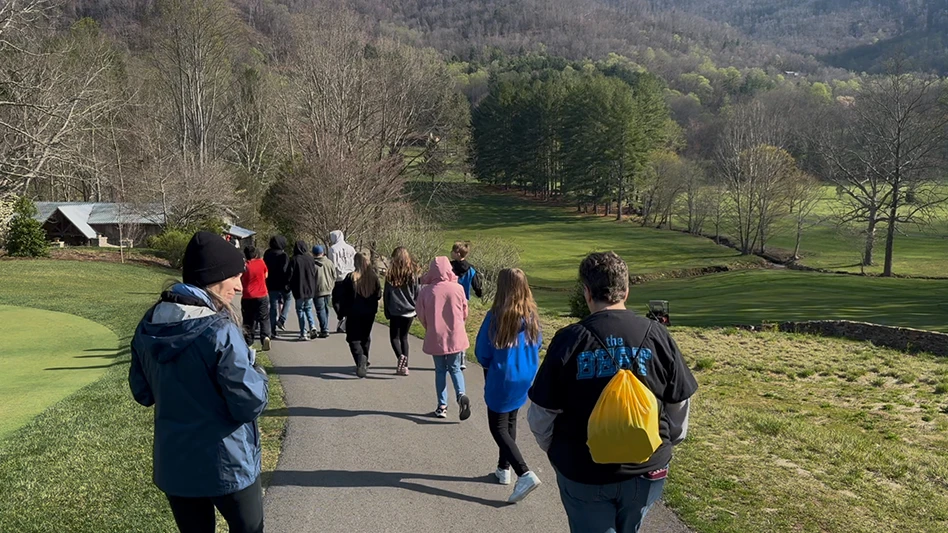Golf course superintendents can be a rather traditional group of professionals.
What has worked in the past will work now and in the future, some will tell you. That philosophy applies to soil testing. There are plenty of supers who like to keep it simple, thank you. Just ask Lance Johnson, CGCS, The Heritage at Westmoor Golf Club and Legacy Ridge Golf Club in Westminster, Colo.
“We use a very basic test for our soil analysis. It does include base saturation but we have had that included for years. Our budget doesn’t allow us to get too fancy with our testing,” he says.
Johnson certainly isn’t alone. Many superintendents feel quite comfortable with some rather basic information, such as pH levels, to determine if their aerification processes are effective, as well as what type and how much fertilizer and other chemicals they should apply to their turf.
But a growing number of superintendents are turning to more detailed testing and analysis, viewing more expansive testing as a way to fine tune their turf management programs and insure complete and long-lasting health of fairways and greens.
pH is only a small piece of the puzzle, says Joel Simmons, president of EarthWorks, Martins Creek, Pa. “When we built a business selling organic fertilizer we realized we needed to understand a client’s soil better,” he says. “If we got the soils right our products worked better.”
Simmons and other soil experts believe that quality and in-depth soil tests should show how much nutrients the soil can hold. A beneficial test should also list the basic anions (negatively charged elements) and cations (positive charged elements), and should show the desired levels of calcium, magnesium and potassium, three vitally important nutrients that make up around 85 percent of the soil base saturation. It is also helpful if sodium, trace elements and hydrogen levels can be listed in a report to develop a more comprehensive picture of the soil.
Soil fertility tests are done to improve turf health and disease resistance; irrigation water uptake tests are used to determine how water impedes plant nutrition uptake; tissue tests are a tool to follow nutrition from the soil to the plant; and soil paste tests measure and compare water nutrient solutions between soil and plant.
Tissue testing can reveal interesting aspects of the soil profile, such as the somewhat disturbing fact that even when the soil chemistry seems in balance, the movement of nutrients may not be adequate enough to give the plant what it needs for proper growth.
Also, when a complete understanding of the soil is reached, it then becomes possible for superintendents to treat their turf, in effect “open it up,” and allow air and water to pass through the soil profile. This will improve drainage, will create a sort of “check and balances” for pathogens, will mobilize nutrients, improve recovery and reduce fertility inputs.
Brian Smith, president of Arizona Sports Turf in Scottsdale, Ariz., believes superintendents are getting the message.
“It takes a while to change habits, but supers are seeing the value of more detailed soil testing and analysis,” he says. “The superintendent will have the information to reach solutions to turf stress and not just apply Band-Aids over and over again on the problem. Some of the issues we find from more detailed soil testing are way more serious than what would be indicated by base saturation testing.”
Detailed information can be used by superintendents to “pick the right nutrient options,” says Smith, which is “critical” to building an effective and sustainable program for turf
Says Simmons, whose firm conducts some 15,000 soil tests a year, “We look at pH, yes, but we also look at the bigger picture – calcium, potassium and nitrogen levels – and gather knowledge on what the soil is doing both organically and chemically. The superintendent can look at a bigger picture and make choices that allow for a more fine-tuned management approach.”
He likes to say, “It’s like we are putting a 100-watt light bulb on a painting where there was only a 20-watt bulb before.”
More and more superintendents are seeing the light.
“I’m not sure I would call them more sophisticated testing methods, I call them more thorough and complete,” says Eric Snelsire, director of grounds at Glen Riddle Golf Club in Berlin, Md. He uses Analync testing offered through Floratine Products and Harris Labs because these tests show exchangeable and extractable nutrients.
“Therefore, it is showing us what is in the soil and how available those nutrients are to the turf plants. The Analync testing provides a complete picture of what is happening under the turf. In addition, the result recommendations are based on an extensive database of all their past turf samples, which take into account our region, soil, water and environmental conditions. We can truly look at the impact of the soil on all facets of plant growth, health and sustainability.”
Brendon Byrne, superintendent at Llanarch Country Club in Philadelphia, has been using saturated paste extract tests from Soil First Consulting in conjunction with soil tests that measure “everything from base saturation to trace elements.”
He says, “I use the saturated paste analysis because it gives me a true picture of what nutrient levels are soluble at that specific moment in the season. It is an advantage to have such a targeted and tangible set of information to review.”
Time used in testing soil is time well spent, says Paul Dotti, superintendent at Arcola Country Club in Paramus, N.J. He tests for pH and nutrient deficiencies twice a year, in the spring and again in the fall, to provide a “benchmark for how to start and end the year” and to allow him to plan for the following season if there is a need to apply lime or gypsum during the winter months. He also conducts tissue testing throughout the summer months to monitor what nutrients the plant is taking up. This allows him to make adjustments to fertility programs “on the fly.” Tissue testing is critical in “optimizing turf health and justifying fertilizer applications,” he says.
Dotti adds, “We use Norm Hummel and ISTRC. Hummel is excellent in assessing soil profiles and topdressing compatibility. If you consider a change in topdressing material, a sample of your green profile and topdressing should be sent for analysis. ISTRC does an inch-by-inch analysis of the soil profile with 4-inch or 8-inch plugs, and they will make recommendations as far as organic matter content, infiltration rates, bulk density and air and water porosity. They also assess growing environments, as well as determine why a green may or may not be thriving.”
Ron Gribble, superintendent at Red Hawk Golf Club in Reno, Nev., utilizes a bevy of tests, including standard soil tests, paste extract testing, tissue sampling and irrigation water testing.
“We have based our entire fertility, soil remediation and integrated pest management programs on this testing,” Gribble says. “We have custom designed our annual programs using testing done every September, and our programs change from year to year based upon data collected. With help from our chemical and fertilizer partners, Redox Chemicals and Arizona Sports Turf, we prioritize deficiencies.”
Detailed soil testing has proved invaluable to the courses Billy Casper Golf manages, says Dan Evers, Mid-Atlantic director of agronomy. “Our partnerships with John Deere Golf and CLC Labs have been extremely valuable,” he says. “BCG superintendents have been able to reduce fertility inputs, while increasing turf density, quality and course aesthetics. It has helped us reduce money spent on fertilizer line items in our budgets.”
Each BCG superintendent works closely with Dr. Chuck Darrah, owner of CLC Labs, who walks them through the soil tests. “Dr. Darrah explains the results and what impact the results have or will have on the turf,” Evers says. “He then makes recommendations and helps the superintendents set up a fertility plan.”
This “no nonsense” approach is key to ensuring that each BCG superintendent is being fiscally and environmentally responsible. “Dr. Darrah also helps the BCG staff navigate through the murky waters of the fad or snake oil products that are rampant in our industry,” he says.
Rob Davis, superintendent at Tonto Verde Golf Club in Rio Verde, Ariz., also says detailed testing helps him “fine-tune” his turf management. “There is a little more expense involved but our fairways and greens are worth it,” he says. “The tests show us a variety of things, such as whether we should increase our aeration program or cut back, or if we should do light topdressing or be heavier with it. The better the turf is balanced the better it will behave.”
Byrne interprets information in two ways. “First, I use experience as a golf course superintendent and my education in agronomy to determine a plan,” he says. “Second, I read Soil First’s summation and analysis of the test results.”
Armed with such detailed information, Byrne has a guide for what type and what amount of fertilizers he needs to apply. In the case of sodium test results, it will determine if he needs to use gypsum.
Testing gives Snelsire the actual amount of calcium, magnesium and potassium bulk amendment recommendations for a three- to six-month period depending on soil types. “We also use some of the information to implement or determine the need to flush the profile when amounts become excessive with any one nutrient, such as nitrogen or sodium,” he says. “The testing has helped us reduce inputs or make strategic applications during certain times of the year to optimize plant health and provide greater growing environments for our turf.”
Matt Fauerbach, Billy Casper Golf’s director of agronomy for the firm’s Northeast Region, says the company’s superintendents view soil tests as baselines for their agronomic plans. “We are working with some courses on grid sampling,” he adds. “This will provide a more accurate map of data across an area and is a more environmentally responsible approach that will ultimately prove to be more fiscally responsible as well.”
“Although our testing budget has increased over the last few years, our chemical and fertilizer expenses have come down,” Gribble says. “We are applying products exactly when and where we need them.” GCI
John Torsiello is a freelance writer based in Torrington, Conn.

Explore the May 2010 Issue
Check out more from this issue and find your next story to read.
Latest from Golf Course Industry
- The Aquatrols Company hires marketing manager
- Renovating Bredemus in West Texas
- Renovation starts at Okatie Creek GC at Sun City Hilton Head
- The Fittest Podcast in Turf: Episode 1
- New 6-hole course debuts in Oklahoma
- GCSAA announces Grassroots Ambassador Leadership Award recipients
- Reel Turf Techs: David Gummo
- PBI-Gordon promotes two to executive level





